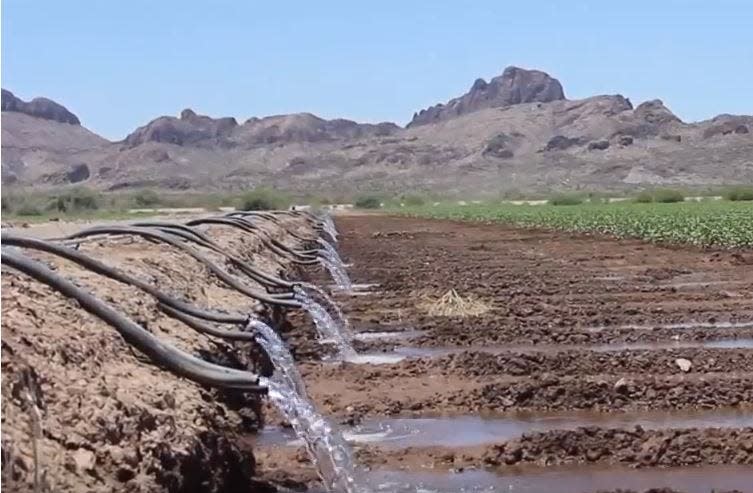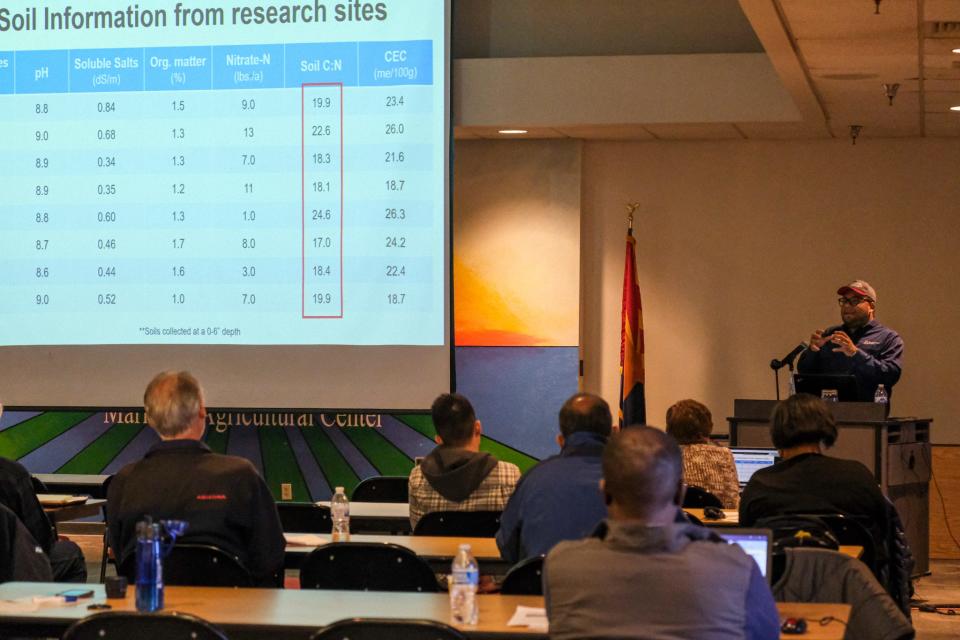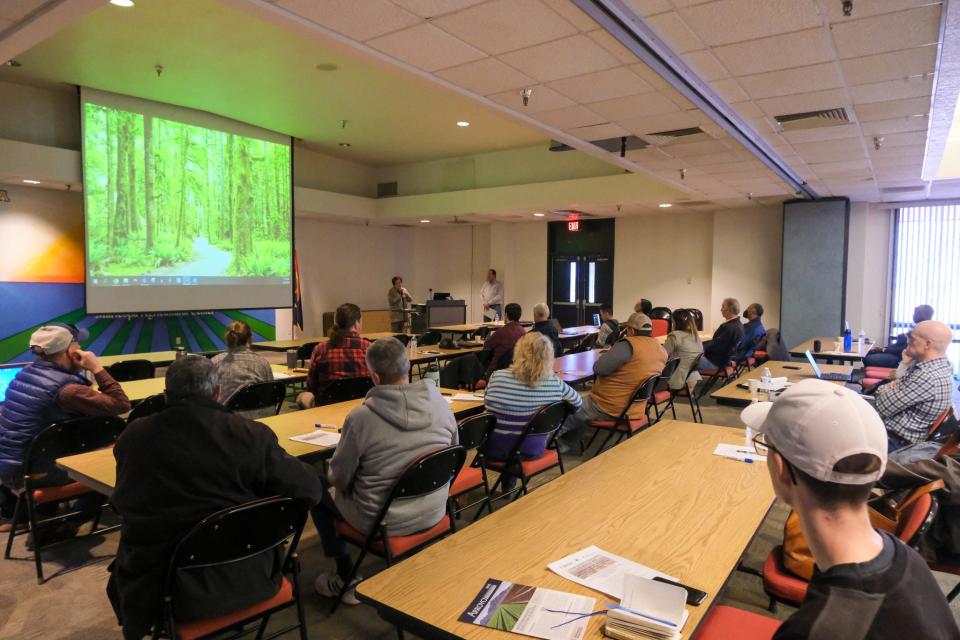Central Arizona farms rely on groundwater. How research aims to help farmers adapt, protect aquifers

Researchers from the University of Arizona are working on groundwater and agricultural research that could help sustainable farming practices in central Arizona.
The project, funded with a $10 million grant from the U.S. Department of Agriculture’s National Institute of Food and Agriculture and led by the University of California, Davis, integrates over two dozen experts from institutions in Arizona, California and New Mexico.
"We need research. We need to know what is happening in the field. I can see what is happening, but I'll be darned if I know how to interpret it about half the time,” said Ron Rayner, a longtime farmer with large operations in Arizona and California who serves as an advisory board member for the project.
As a megadrought drains the Colorado River reservoirs and water cuts are enacted, farmers across the Southwest are turning to groundwater to sustain their operations. This has caused unprecedented overdraft in aquifers in the Central Valley of California, central Arizona and the Lower Rio Grande basin in New Mexico, according to project leaders.
The multistate groundwater research project aims to lessen the impact on the aquifers, while helping farmers and irrigation districts adapt to the new reality.

In Pinal County, where Colorado River cuts were the harshest, growers saw an 87% reduction in surface water allotments from one year to the next. This year, through outside agreements, they will receive 5% of what they were allotted in 2021.
“It's basically back to the days before we had (Central Arizona Project) surface water," said Bryan Hartman, a farmer and board member of the Maricopa-Stanfield Irrigation and Drainage District, who is also on the advisory board for the university project.
The district got its first delivery of Colorado River water through the CAP Canal in 1987 and was expected to keep it until at least 2030. With drought contingency plans, that deadline was reduced roughly by seven years. The district is now running about 99% on groundwater.
Because farmers were using CAP water all those years, the aquifer experienced a substantial recharge. Irrigation districts and other entities have earned "credits" over the years for leaving water underground. They can now use those credits to pump water.
Keep reading: How Colorado River cities are preparing for shortages with conservation and alternate sources
"Some people are entitled to recover those credits, while the farmers still have all the rights to pump, because (they) haven't lost any groundwater pumping rights," said Sharon Megdal, director of the UA's Water Resource Research Center and leader of the project in Arizona.
Now there are numerous water users competing over the same resource. It’s like there are two straws going underground, Megdal said, the credit recovery straw and the agricultural straw, and both are pulling from the same aquifer.
Hydrologists, engineers, plant and soil scientists, economists, agricultural extension experts and educators with the USDA-funded project are working in tandem to develop management strategies and integrate data for better decision making. The project will conclude in August 2026.
Water quality and availability

The Arizona team, including Megdal, soil health specialist Debankur Sanyal and graduate research associate Simone Williams, is mainly focusing on building a water quality model, assessing soil health, and developing water availability scenarios.
On Tuesday, the team held a conference at the Maricopa Agricultural Center to share advances from the project, and hear remarks from project advisory board members.
Using an hydrology model, called the Soil and Water Assessment Tool or SWAT, Williams will measure and predict the impact of irrigated agriculture within the Pinal Active Management Area on groundwater availability and quality. The AMA, created to carry out regulations for groundwater pumping, covers most of the county's farmland. While there is an obvious and widespread concern about quantity, Williams suggested quality doesn't get the amount of attention it should.
As water resources become more limited, the high content of salinity, nitrates and other contaminants in nearby wells will become a more pressing issue.
Opinion: How to make the Colorado River sustainable for the long term
"Because we are in a semi-arid area, most people are laser-focused on the quantity of water. But if what is in the ground is unusable, then it makes the problem worse," Williams said, adding that results from this project could help raise awareness on the issue.
Water quality is already a matter of litigation in Pinal County. In 2020, the Ak-Chin Indian Community, located in the northwest part of the county, filed a lawsuit against two irrigation districts that the tribe said were blending poor quality groundwater with surface water coming from the Central Arizona project, which the tribe is entitled to receive.
High levels of salinity can affect the growth and health of many crops. Potatoes, which Ak-Chin farms grows, are particularly susceptible. The tribe saw yields drop. Most farmers in Pinal County have turned to grow salinity-resistant forage crops.
Fertilizers can also leach high levels of nitrates into aquifers, making water unsafe to drink. The model could inform farmers and irrigation districts about the quality and nutrient content of the groundwater they are using, indicating the need for treatment or allowing them to reduce fertilizer input and costs.
The general public will be able to access the model through an interactive online tool once the project is completed. Because the model will work at a sub-basin scale — there are 33 of them within the Pinal AMA — users will have an idea of the section of the aquifer they are drawing water from.
Cover crops for soil health, irrigation technology
Debankur Sanyal believes that even in limited-water scenarios, like the one Pinal County farmers face, there can be an investment return for improving soil health.
The obvious challenge of not having enough water for an additional crops could have good returns for the farmer and the land. Good nutrient balances and soil microbiology can capture more moisture, and make water use more efficient, Sanyal said. Working with farmer partners, he has been testing a number of summer cover crops in eight field sites, monitoring their effect on soil.
The project also aims to define soil health metrics that are specific to the central Arizona region, and help farmers make better decisions to improve their land's health and productivity. The research project also factors in the investment and return of planting these crops.
Water cuts from the CAP have are already forced many Pinal County farmers to leave half of their land unplanted.
Isaya Kisekka, an associate professor of agrohydrology and irrigation at UC Davis and the lead investigator for the project, said that, although unfortunate, the dramatic water cuts create an opportunity to expand irrigation technologies and better practices.
In California, farmers’ interest in irrigation monitoring and technology, as well as technical consultation, grew with the implementation water limitations coming from policies like that state's Sustainable Groundwater Management Act. Something similar could take place in Arizona, he said.
"The policy has created an environment that encourages these technologies, many which are not new," Kisekka said. While many farmers opted out because they didn't see a big investment return, that decision could change under the current scenario. "The motivation now is not to make more profit, it is to keep farming."
Clara Migoya covers environment issues for The Arizona Republic and azcentral. Send tips or questions to clara.migoya@arizonarepublic.com.
Environmental coverage on azcentral.com and in The Arizona Republic is supported by a grant from the Nina Mason Pulliam Charitable Trust. Follow The Republic environmental reporting team at environment.azcentral.com and @azcenvironment on Facebook, Twitter and Instagram.
Support environmental journalism in Arizona. Subscribe to azcentral today.
This article originally appeared on Arizona Republic: Arizona farms now rely on groundwater. Research aims to help farmers adapt

